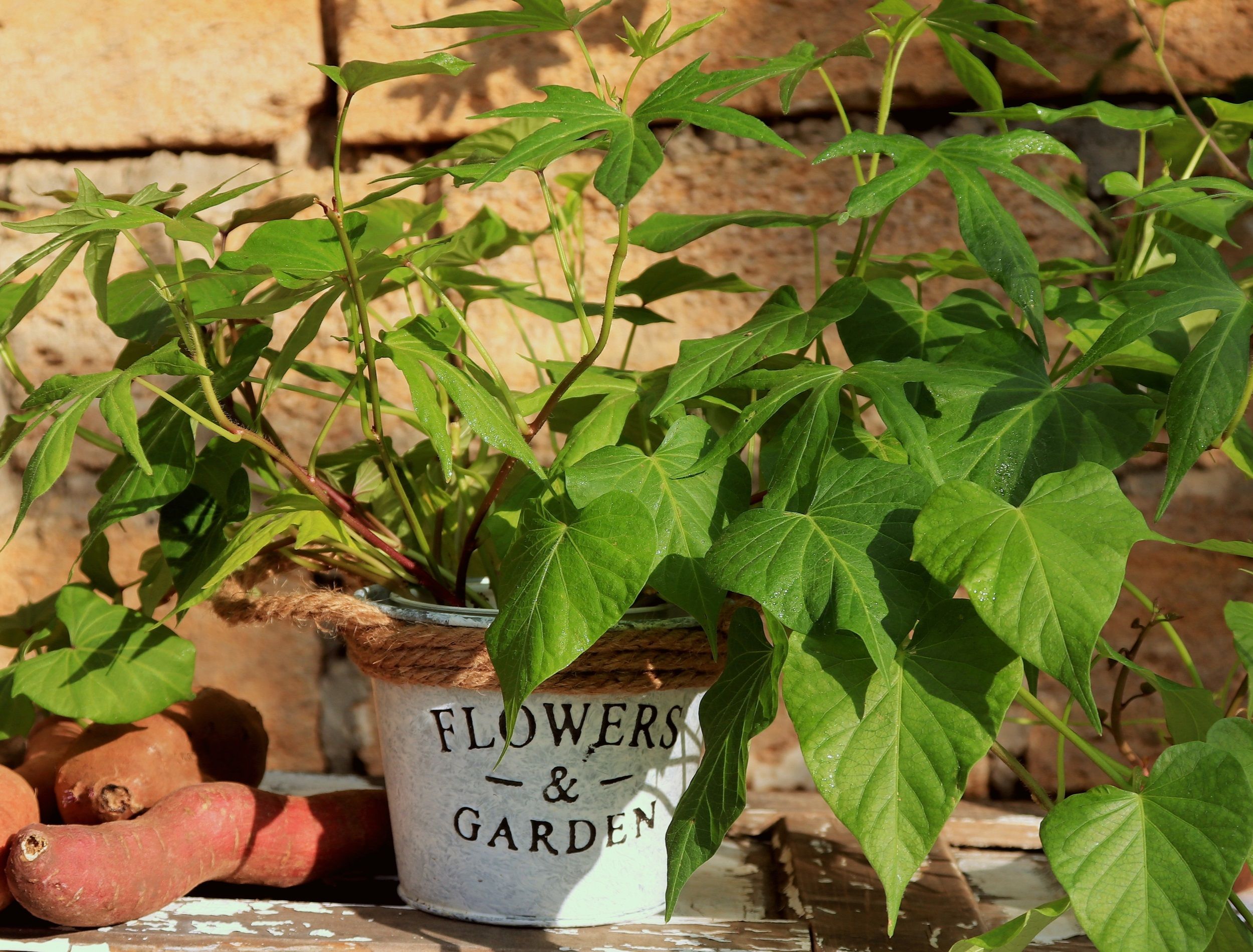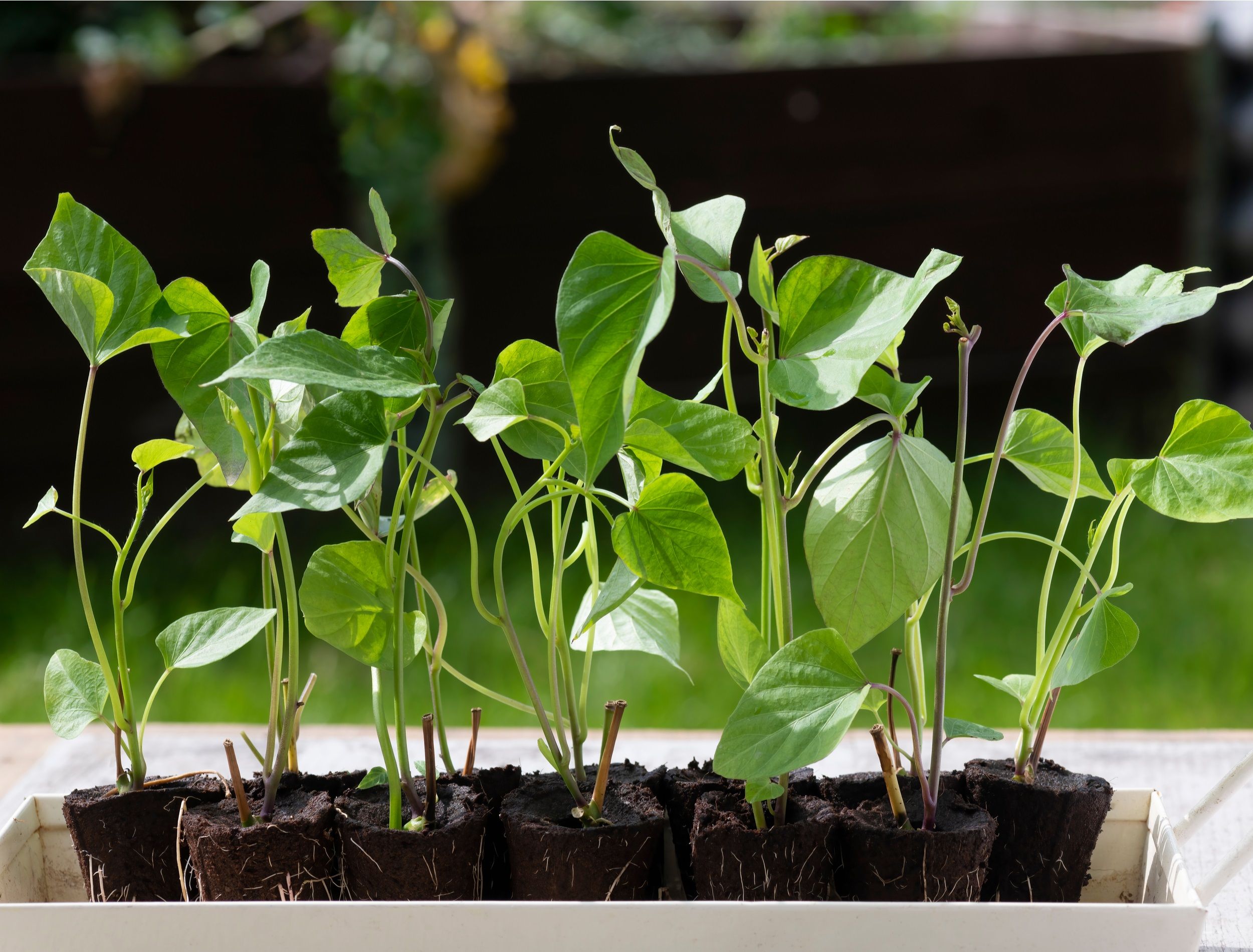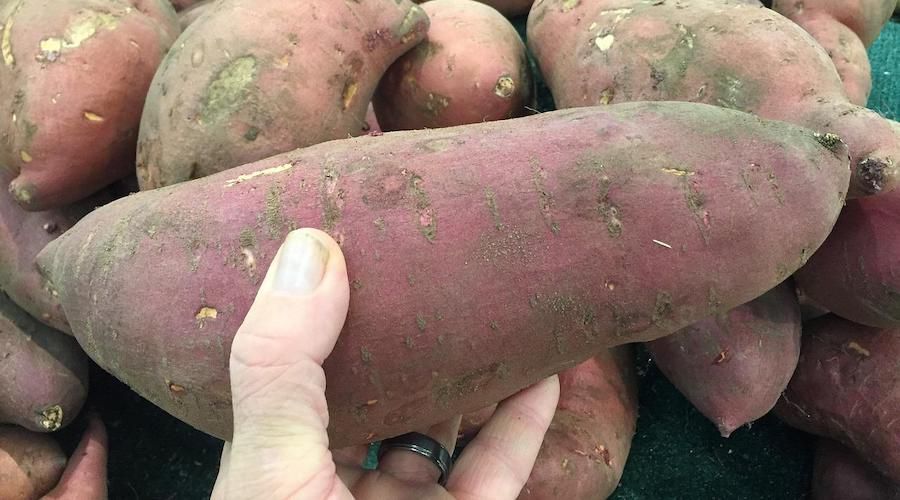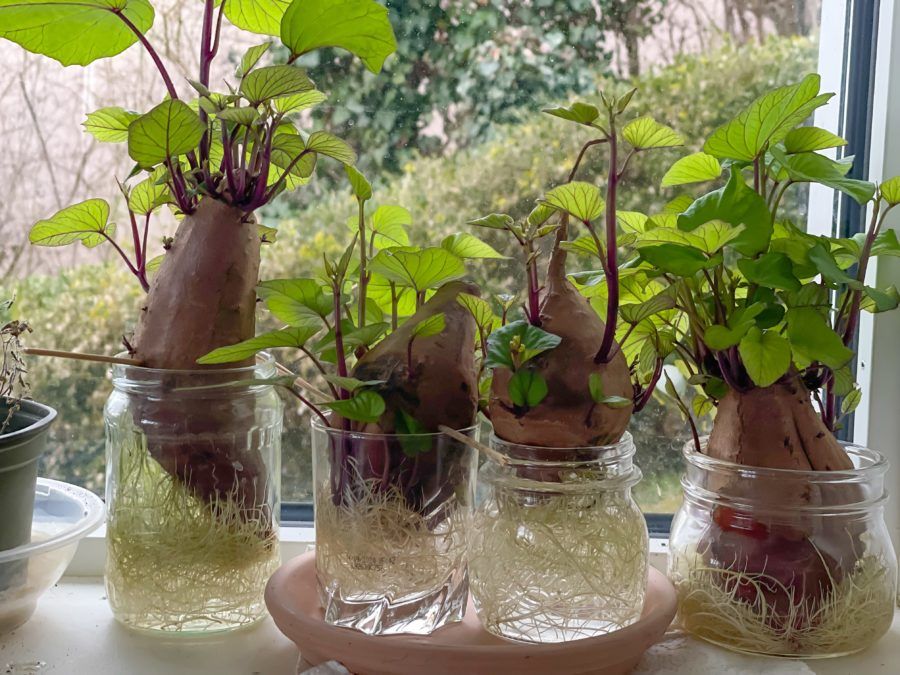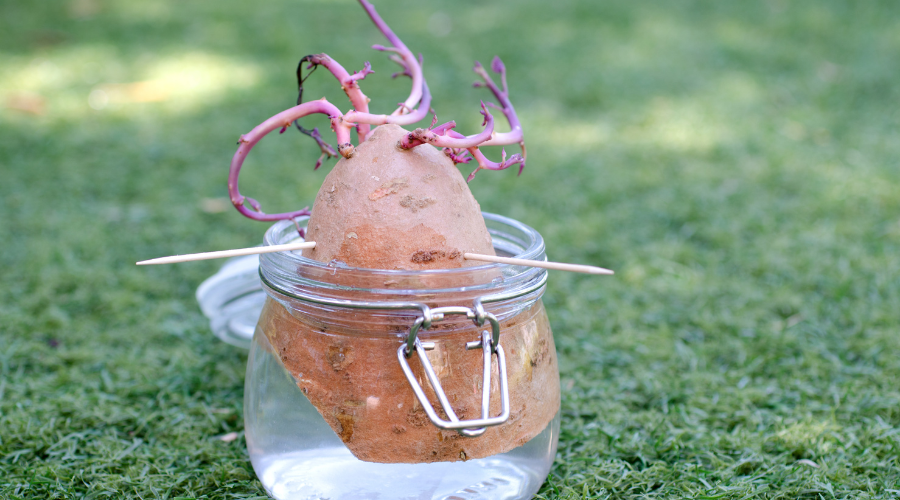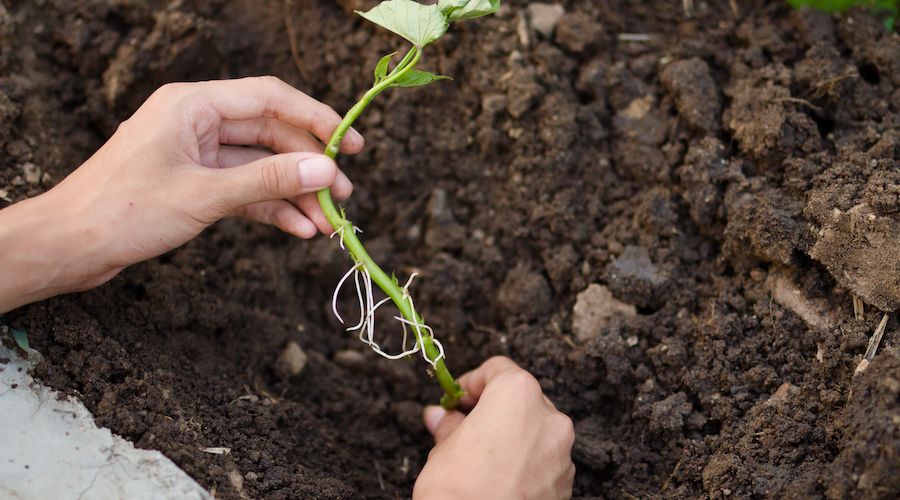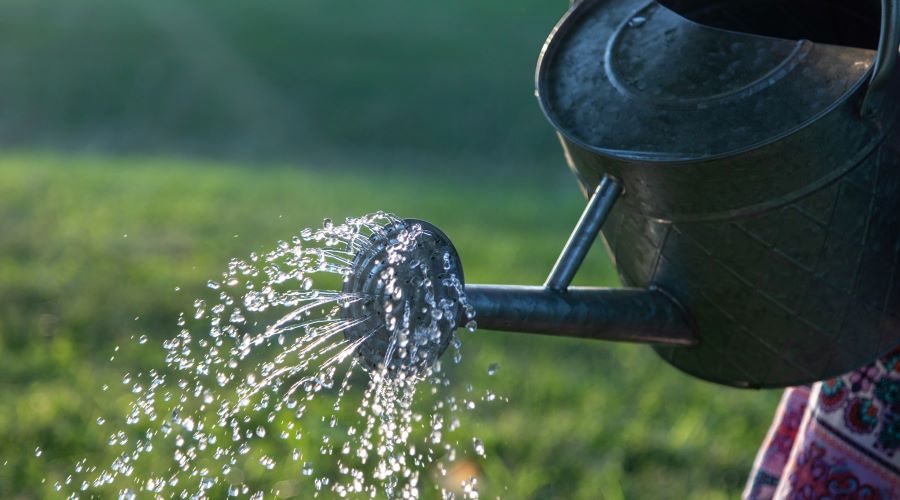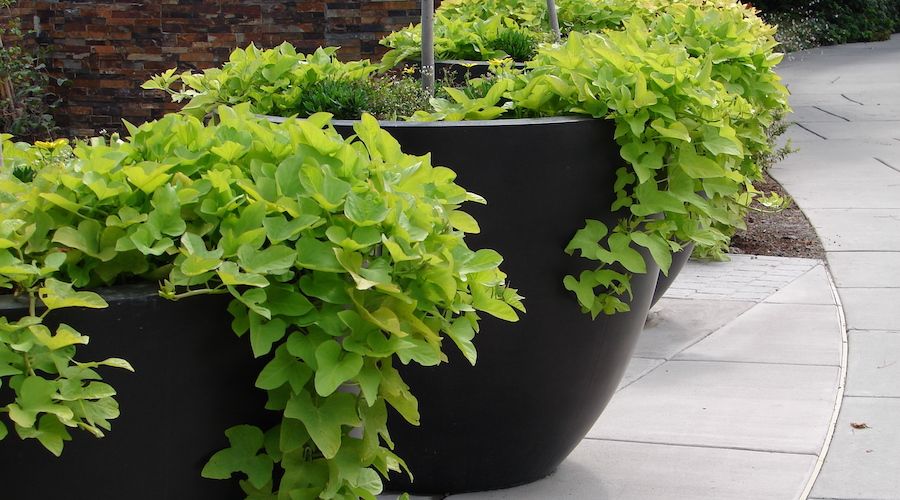A lot of people take up gardening as a hobby, mainly because they need a relaxing activity to start or end their day. However, for many of us, it is also a way to grow food and a step on the path to self-sufficiency.
One of the all-time favorites to grow at home are sweet potatoes. Normally, you see these veggies growing in the ground, but when you have little space to spare, containers are your best bet.
While it may seem complicated, growing and caring for these plants in a container is pretty straightforward. Here is an in-depth, beginner-friendly guide to growing sweet potatoes in containers.
What You Will Need to Follow This Tutorial
Image credit: Deborah Lee Rossiter via Shutterstock
Growing sweet potatoes in containers can be challenging, therefore, it is crucial to have the needed materials and tools ahead of time. Materials-wise you will need:
- Sweet potato tubers
- Toothpicks
- Water
- Potting soil
- Containers to plant in
- Slow-release fertilizer (while this is optional, it is recommended to get the best results)
As for tools and equipment, you will only need:
- Knife
- Shallow dish
- Glass containers (one for each tuber )
- Thin nail
Step-by-Step Tutorial on How to Grow Sweet Potatoes in Containers
Step 1: Prepare the Sweet Potato Tubers
Image credits: LouSipolt via Pixabay
First, look for sweet potatoes that have no damaged spots and are firm to the touch. Avoid refrigerating the ones you will use to grow your batch of sweet potatoes. Next, you will use your knife to cut the tubers into pieces a little smaller than the opening of your glass container.
Then, find the middle of each tuber piece and put three or more toothpicks into it - Make sure there’s enough space between them. Also, ensure the tubers don’t go deeper than half to one inch.
Pro Tip: If making a hole with a toothpick is too difficult, use a thin nail to do the job. Use a nail, make the hole, and then place the toothpicks inside to hold the tuber firm on the container opening.
Step 2: Position the Sweet Potato Tuber in the Water
Image Credit: Eurybia via Shutterstock
Place each tuber in a way that lets the toothpicks rest on the edge of the glass container. The pointed end of the tuber should be looking down inside the container. Next, add enough water so that the bottom half of the tuber is covered. Then, put the container in a sunny spot and change its water every few days while at the same time ensuring that you cover the bottom of the tuber with water.
Pro Tip 1: You may need to wait up to a month before the tuber sprouts from the top. These are known as “slips” and are what you will use to grow your batch of sweet potatoes.
Pro tip 2: Test the water you use in your glass container. If it is rich in chlorine, chances are the slips won't sprout. In such cases, use distilled water.
Step 3: Separate the Sweet Potato Tuber Slips
Image credits: cmspic via Canva
Once the sweet potato tuber has produced sprouts, you must carefully separate them from the tuber one by one by gently twisting them free. Be careful though, there may be a rudimentary root structure that has grown on the slip that you should not disturb.
Next, take a shallow dish filled with water and lay every slip inside. Make sure that water covers the bottom of the stem, and that the leaves are hanging over the edge. In a few days, you will see new roots growing on the slip. As soon as the new roots have reached a length of about an inch, you can plant the slips in potting soil.
Step 4: Plant the Slips in Containers
Image credits: Piyaset via Shutterstock
Using garden soil isn't recommended as it can suffocate your container plants. Here's a fantastic article about the difference between potting soil and garden soil to help you decide. Your next step would be to fill a container with potting soil. Make sure it doesn’t go higher than one inch below the rim.
Next, mix some slow-release fertilizer as this will give the plant the boost they need to grow. With your fingers, make a hole in the middle of the soil, but only deep enough to cover the roots. Put one or two slips in and pat the surrounding soil gently, but firmly, to keep everything in place.
Step 5: Water Your Plant
Image credits: David Ballew via Unsplash
Finally, for the first couple of days, water your plant lightly twice a day. Keep it away from direct sunlight to avoid transplant shock. After a couple of days, keep the container in a sunny spot. Ensure that the soil is moist but don’t over-water it.
To find out whether you need to water your plant or not, put your finger inside the soil up to your first knuckle. If, when you take it out, your fingertip is wet, it means that the plant still has enough water. If it’s dry, it means you should water it.
Step 6: Moving the Sweet Potato Plants Outside
Image credits: Kathryn Roach via Shutterstock
If you want to keep your sweet potato plants outside, there are a few things you need to keep in mind. First, they like warmth, so before moving them, ensure that there is no risk of frost, as sweet potatoes are extremely frost-sensitive. The optimal temperature is between 65 and 85 degrees Fahrenheit, that way they will gradually acclimate to the outside weather.
As for harvesting your potatoes, you can harvest them at any stage - they will still be edible. Different varieties take different amounts of time to mature, so check what the harvest time is for your type of sweet potato. Either way, harvest them before the frost comes.
Pro Tip: If you want to extend the shelf life of your sweet potatoes and get as much flavor as possible out of them, keep them in a warm and dry place for up to two weeks before you eat them!
Frequently Asked Questions
Image Credit: Narsil via Shutterstock
1. How big should the container be to grow sweet potatoes?
A 15-20 gallon container is ideal for growing sweet potatoes. The larger the container, the easier it will be to grow and harvest these veggies. An example of a 16-gallon container is a half whisky barrel. They make excellent planters for growing root veggies.
2. How many slips can you plant in a five-gallon bucket?
In a five-gallon bucket, you can only plant one slip as sweet potato roots need a lot of room to grow and thrive. Keep in mind that one slip will yield you between five and ten sweet potatoes.
3. How long does it take to grow sweet potatoes in containers?
If grown in ideal conditions, sweet potatoes will be ready to harvest after 150 days or close to five months.
4. When's a good time to plant sweet potatoes?
Spring is the best time to plant sweet potatoes. If you live in an area that doesn't experience frozen grounds, plant your sweet potatoes a month after the last spring frost.
5. How do you know when the sweet potatoes are ready to harvest?
If you're unsure about the harvesting time of the type of sweet potatoes you've grown, let the plant and weather guide you. When the tops of the plant vines are dry and dead, your sweet potatoes are ready for harvest. Dead vines mean that the sweet potatoes have completed growing and are ready for harvest. After harvesting, here are a few delicious potato recipes you can try to make.
6. How often should you water your sweet potato plants?
As mentioned above, test with your finger to see if your plant needs water. After transporting the plant container outside, slips will need to be watered daily for the first week. During the second week, water them every other day to help establish them. After they're established, you can water them once a week.
7. How to get rid of whiteflies from sweet potato plants?
Sweet potato plants are susceptible to whitefly infestation. Whiteflies can cause significant damage to your plants as they encourage the growth of a fungal disease known as black sooty mold to grow on them. To get rid of them, you'll need sticky tapes, neem oil, and a handheld vacuum cleaner among other things. Here's an interesting article that talks about how to get rid of whiteflies.
8. Can we grow sweet potato plants directly from a tuber?
It is possible to grow directly from the tuber by shallowly burying it in the container. But, this can result in stunted growth because of a cluster of slips and rot from the tuber. Gardeners often prefer that sweet potatoes be grown from slips instead of planting an entire potato to avoid introducing disease into your garden.
Get Your Tuber!
Whether you want to relax or be self-sufficient, learning how to grow plants in containers is a very important skill to have. One of the all-time favorite plants to grow is the sweet potato. And while it may seem complicated, growing sweet potatoes in containers is easy.
Hopefully, this article was helpful to you! If it was, please share it with your friends and family and let us know what you think in the comment section down below!

